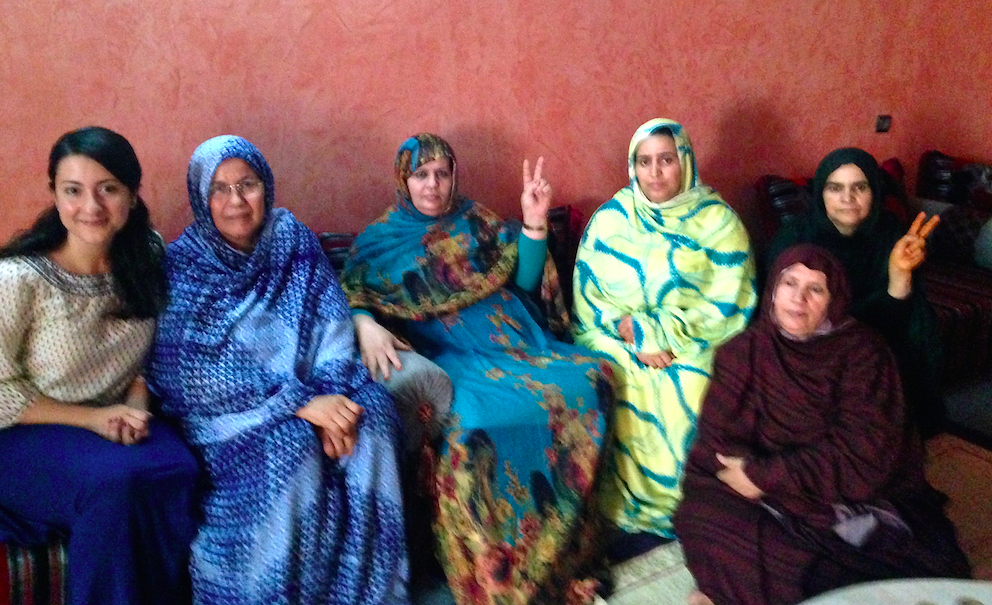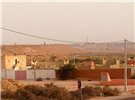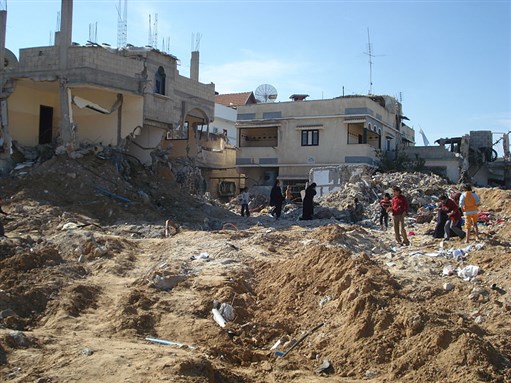[The following article is the first in a two-part series tracing the roots of settler-colonialism and military occupation in the Western Sahara. Read the second part here.]
Upon entering the Occupied Territories of the Western Sahara, I organized a focus group in the private living room of a Sahrawi activist’s home in Laayoune, Western Sahara, where nine activists were brought together. They were each imprisoned for varying periods of time between 1980 and 1991, while the Moroccan state warred with the Polisario Front. They met each other while in the prison of Kela’at Megouna, and were determined to share their stories in vivid and haunting detail.
Sukeina was tortured for four months in various positions, including one called “the chicken” where they would have their legs tied up and hands behind their back while being hung upside down. She was tortured beside a woman named Hunaatha, and they kept each other company when they were left alone. When the Moroccan security forces hung Hunaatha upside down, she fatally fell from the torture position as Sukeina watched.
Each activist in that room, man or woman, experienced a similar sequence of events: taken into custody, imprisoned without trial, beaten, tortured, and moved to secret detention centers throughout Morocco, from Casablanca and Agadir, to the northern area of the Occupied Territories. They all came out with physical scars, permanent injuries, and lost friends and family members during their prison terms.

[Sahrawi activists in Laayoune, Western Sahara. All met while imprisoned in Kela`at Megouna. Image by author]
These activist narratives offer just one glimpse into the mass violation of human rights the Moroccan occupation has perpetrated against the Sahrawi population of the Western Sahara during the last several decades. Relentless violations occur on a daily basis despite the United Nations’ and various European non-governmental organizations support for decolonization, self-determination, and human rights.
Settler-Colonialism as the First Phase of Conflict
The United Nations’ declaration calling for global decolonization and self-determination for colonized peoples in 1960 did not eliminate the possibility of future long-term military occupations and colonial interests. It did not instantly create a postcolonial era and world order. Instead, countries acting in their own self-interest and seeking territorial aggrandizement have utilized aspects of colonialism and occupation to achieve their goals while relying on international alliances to escape criticism and legal repercussions.
It is necessary to understand the analytical imperative for viewing settler-colonialism as significantly different from other traditional and classical forms of colonialism. Many scholars have written extensively on the intricacies of settler-colonialism from the nineteenth century to the annexations of territory that occurred in the twenty-first century. The common conclusion is that settler-colonialism modifies the demographic composition of the colonized territory in severe ways that are much different to traditional and classical forms of colonialism.[1] Once demographics are modified, there is a contestation over who has right to the land. This becomes especially contentious once a settler-colonial project lasts multiple generations, as is the case in the Western Sahara.
Lorenzo Veracini, a prominent scholar who has written extensively on settler-colonialism and published Settler Colonialism: a theoretical overview, provides a concise yet complex definition of settler-colonialism. He considers it a distinct method of colonizing that involves the creation and consumption of a wide array of territorial spaces by settler collectives on behalf of the colonizing state. The settler collectives then claim and transform places by exercising their sovereign capacity, which is reinforced by their home country.
This form of colonialism is started in the name of national aggrandizement, and mobilizes thousands of people to physically and politically support the project. The expectation is that the colonial project will be irreversible and will transform the newly claimed territory into a legitimate part of the colonizing state thus making the colonized population invisible.[2] Therefore, understanding the impact of settler-colonialism on the colonized population requires the dismantling of the invisibility of colonized populations and those that are displaced. This process reveals the internal dynamics and institutions of colonial power that the colonizer obscures for its own interests.[3]
In order to understand the impact of the settler-colonial project in the Western Sahara it is necessary to understand how it came about, how it was justified, and the amount of Moroccan settlers that migrated from Morocco-proper. The Occupied Territories of the Western Sahara were formerly part of a Spanish colony. In 1884 Spain obtained a protectorate over the territory and assumed full military and administrative control.[4] After the passing of a United Nations General Assembly declaration granting colonial countries independence in 1960, Spain relinquished official colonial rule over the Western Sahara and accepted responsibility for preparing a referendum for the formerly colonized inhabitants. The purpose of the referendum was to provide Sahrawis the opportunity to decide the fate of their territory, including the options of self-determination and independence. [5]

[Image of Sahrawi homes that were constructed during Spanish colonial rule.The dome style was chosen so that the inside of the homes stayed relatively cool during times of extreme heat. Image by author.]
Despite the importance of UN declaration 1514 and the emphasis placed on self-determination for formerly colonized populations, Morocco stalled the referendum process by submitting an appeal to the International Court of Justice (ICJ) in October 1974, arguing for rights to the territory due to historical ownership.[6] The Moroccan state’s claims to the Western Sahara emerged due to the nationalist belief in the recovery of terra irredenta, claiming that its land had been contested and lost to European colonial ambitions for centuries.[7] During the investigation into the factuality of Morocco’s claim, the ICJ only found some pledges of fealty to the Moroccan sultan in the nineteenth century by a few select tribal leaders bordering southern Morocco.[8]
The ICJ concluded that there was insufficient evidence to support any legal historical claim to the territory that would trump the Sahrawis’ right for self-determination and the referendum process.[9] Although the ICJ rejected the Moroccan state’s appeal and supported the fulfillment of the application of resolution 1514 in the decolonization of Western Sahara, King Hassan II proceeded to claim the territory and initiate a project of settlements and occupation.
The Green March of 6 November 1975 was the definitive beginning of Morocco’s settler-colonial project. It was a state-initiated mobilization following King Hassan II’s speech delivered 16 October 1975, and consisted of thousands of Moroccan citizens who marched south toward the territories. There were approximately 350,000 participants that settled in the Western Sahara, led in by tanks and the Moroccan military.[10] Following this aggressive move, Spain granted Morocco two-thirds of the territory and by 14 November had abandoned all responsibility for conducting a legal referendum.
In order to mobilize popular support in the hundreds of thousands, the king provided economic incentives for the settlers and they were given generous housing subsidies for their quick relocation.[11] The king also delivered many grandiose speeches rooted in nationalist discourse to inspire support for his project from the greater Moroccan citizenry:
I recommend that your beloved country, your fatherland Morocco…safeguard its independence. Defend its historical territorial unity. Don’t tolerate that its liberty and integrity be touched one inch. Take care not to accept any bargaining concerning its safety and that of its inhabitants…In danger’s time, and when the enemy threatens your country, beat the head of its defenders..[12]
King Hassan II intentionally framed the Green March as a nationalist project that was to preserve the territorial integrity of the Moroccan state. His speeches regarding the march and the occupation of Western Sahara are filled with divisive language that emphasizes the importance of a unified populace and pits all Moroccans against those who oppose their project. The king’s nationalist discourse came at a crucial point in his reign, since it took place after two attempted military coups. Therefore, the Green March served to reinforce King Hassan II’s legitimacy and stabilize his reign. Territorial integrity and unity are justifications still used today by King Mohammed VI to mobilize popular support for ruling over the Western Sahara.[13] It is not framed to the public as a project for obtaining other self-interests such as natural resources or greater territory. Instead, the march was to reclaim land that is undeniably theirs, regardless of the lack of historical evidence for such a claim.
The Green March was, for all intents and purposes, a grand political strategy on behalf of the Moroccan government under the reign of Hassan II. The possibility of a Sahrawi referendum process deciding the future of the Western Sahara presented the greatest obstacle of achieving control of the territories. In the initial process of creating the referendum, the Identification Commission (IDC) of the United Nations Mission for the Referendum in Western Sahara (MINURSO) utilized a 1974 census that Spain conducted in the territories and identified eligible voters in the Tindouf refugee camps. The IDC identified 86,425 eligible voters by 15 January 2000, and allowed that figure to be appealed. The Moroccan government lodged approximately 131,000 appeals by 28 February.
The monarchy decided to complicate the possibility of a limited referendum electorate by incorporating hundreds of thousands of Moroccan citizens into the population and politicizing identity. In the event of an actual referendum taking place, some of the settlers could claim the right to vote because some were of ethnic Sahrawi background.[14] Over time it would become more and more difficult to establish a just referendum process that could exclude the entire settled population in the Western Sahara, which is precisely what has stalled this plan for the last thirty-nine years.
According to the Moroccan government and many of its citizens, the Green March is the critical moment in Moroccan history where the state embraced its post-coloniality and reclaimed all of its land from European colonizers.[15] Although the state fails to address the Spanish jurisdiction over Ceuta and Melilla as they continue to challenge the assertion of post-coloniality, the reclamation of the Western Sahara is commemorated annually by a speech broadcast all throughout the state.[16] However, what this perspective does not acknowledge is the fact that an entire population lived in those territories prior to the Green March, and were consequently disenfranchised and exiled.
The settlement of hundreds of thousands of Moroccans resulted in the forceful displacement of thousands of Sahrawis who have since lived in refugee camps in Tindouf, Algeria for decades. In addition to the total lack of consideration for the Sahrawi population that supports an independent state, there is no legitimate or substantial evidence that supports Morocco’s claim of historical control and ownership of the Western Sahara. Therefore, the counterargument of believing the Western Sahara is Moroccan without a doubt falls apart when considering the lack of evidence supporting any of the monarchy’s statements regarding rightful claim.
A variety of factors motivate the Moroccan’s state’s political strategies for claiming the Western Sahara and settling throughout the territories. These factors are composed of self-interested motivations to control raw materials, create new lucrative international trade agreements, obtain more territory, and maintain security. These self-interested motivations inarguably fit into a traditional colonial logic that has existed for centuries, and that many scholars have utilized to understand the motivations and factors that influence sustained military occupations throughout the world.
The Politicization of Identity
Identity politics plays a large role in the intractability of this conflict, which the Moroccan government has expertly utilized. In addition to creating a large Moroccan settler population in the Western Sahara, the Sahrawi-spoken Hassaniya dialect was added to the 2011 constitution as an aspect of Moroccan national identity. Although the dialect was added for symbolic purposes, its presence directly counters the argument of Sahrawi pro-independence activists that Sahrawis and Moroccans are ethnically and culturally distinct. Additionally, the government provides significant economic and social incentives for Sahrawis to support the occupation that have politicized self-identity amongst the Sahrawi population. As a result, the politicization of Sahrawi identity has yielded tensions that have manifested themselves, for example, in the form of violence in universities. A more specific example of this is the protest that erupted in April 2011 following the death of a Sahrawi university student in Rabat.
Sahrawis living in the Occupied Territories and in Morocco-proper that are vocally pro-Morocco escape many forms of institutionalized discrimination, and this position is in certain cases accompanied by economic incentives. Thus, self-identity has been highly politicized by the Moroccan state in hopes that it can influence voting positions. The task of sorting through the issues of self-identity and politics while creating a referendum has been the greatest source of intractability throughout the years. A large part of the debate that surrounds this conflict focuses on how many Sahrawis support the territories’ incorporation into Morocco versus those who support independence. While many will continue to argue back and forth about the popularity of each political stance, it is clear that only one thing can legally and democratically resolve this issue: a referendum.
[Parts of this article were originally published by Muftah.org. This research was made possible thanks to grants provided by the Georgetown Institute for Women, Peace, and Security and the Georgetown Center for Contemporary Arab Studies.]
[1] Veracini, L. (2010) Settler Colonialism: a theoretical overview. New York: Palgrave Macmillan: Cambridge Imperial and Post-Colonial Studies Series. Ebook.
[2] Bateman, F. & Pilkington, L. (eds.) (2011) Studies in Settler Colonialism: politics, identity and culture. New York: Palgrave Macmillan.
[3] Veracini, p. 3
[4] Jensen, E. (2005) Western Sahara: Anatomy of a Stalemate. 2nd ed. Boulder, CO: Lynne Rienner Publishers. Print.
[5] Bahaijoub, A. (2010) Western Sahara Conflict: Historical, Regional and International Dimensions. London, UK: North South Books. Print.
[6] Soroeta-Liceras, J. (2011) El Conflicto del Sáhara Occidental: Reflejo de las Contradicciones y Carencias del Derecho Internacional. Bilbao: Universidad del País Vasco, Servicio Editorial. Print.
[7] Zunes, S. & Mundy, J. (2010) Western Sahara: war, nationalism, and conflict irresolution. Syracuse: Syracuse University Press. Print.
[8] Zunes, S. (2006) “Western Sahara; the Other Occupation”. New Middle East. January/February, pp. 49-52.
[9] International Court of Justice. Western Sahara: Volume 1: Request for Advisory Opinion, Written States and Documents. December 17, 1974. Online: http://www.icj-cij.org/docket/index.php?sum=323&p1=3&p2=4&case=61&p3=5
[10] Zunes & Mundy
[11] Zunes, p.50
[12] Rhanem, Karima (2014) “Morocco Commemorates Green March 39th Anniversary”. Morocco World News. November 6. Online: http://www.moroccoworldnews.com/2014/11/143298/morocco-commemorates-green-march-39th-anniversary/
[13] Agencie Marocaine de Presse (2012). “Full text of the royal speech to the nation on 37th anniversary of the Green March”. November 6. Online: http://www.map.ma/en/discours-messages-sm-le-roi/full-text-royal-speech-nation-37th-anniversary-green-march
[14] Zunes, p. 50
[15] Rhanem, online article.
[16] Rhanem, online article.
![[Landscape shot of Laayoune from the south-west of the city. Image by author.]](https://kms.jadaliyya.com/Images/357x383xo/ScreenShot2015-01-09at7.50.43AM.png)















